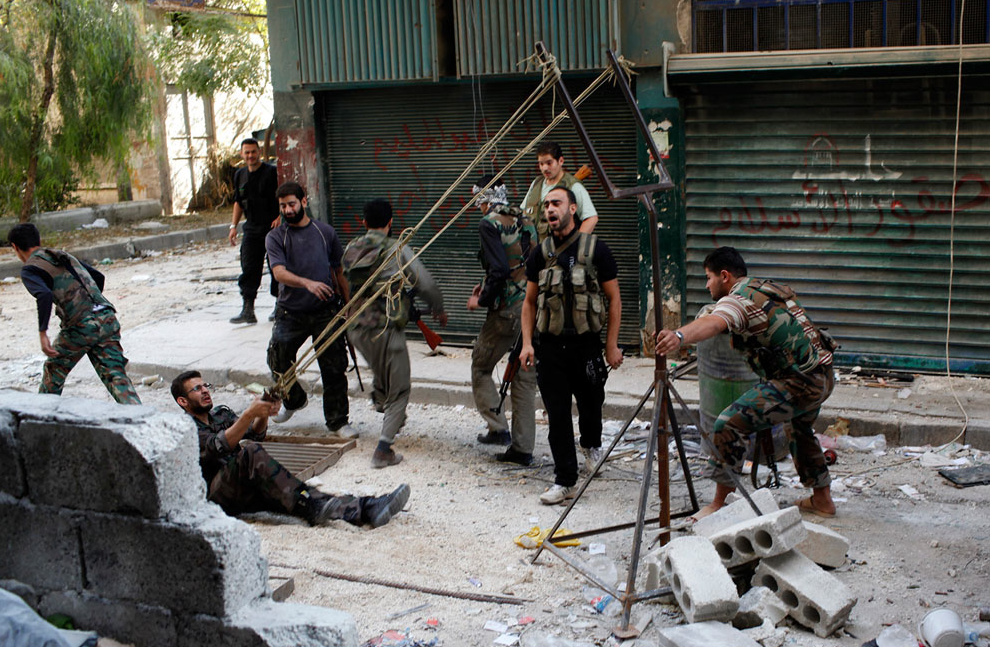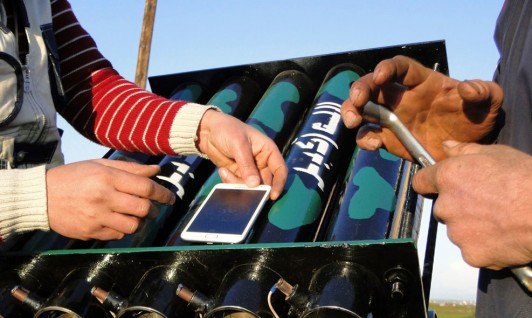With sequestration staring us in the face and all of the teeth gnashing concerning the possibility that the Department of Defense will be confronted with $500 billion dollars in budget cuts over the next ten years—no small chunk of change, but nevertheless a relatively small part of the overall DOD budget—I was intrigued by the photographs, such as the one above, coming out of Syria that show the primitive and makeshift weaponry employed by the Free Syrian Army.
The slingshot or catapult can be traced to ancient and medieval times, but in the contemporary era it is usually associated with rebel or guerilla warriors (think of all of the images we regularly see of Palestinian youth using slingshots to hurl rocks at Israelis), in large measure because it requires so little in resources to make it work. State sponsored armies have budgets that can be cut, rebels and guerillas … not so much. And so the later cobble together whatever is available, converting the objects of ordinary life into weapons of war.
It is this last fact that bears some attention. Elsewhere we have talked about how war has been normalized by being made more or less invisible in the United States, such that the accouterments of warfare have been converted into everyday objects that appear to have no connection to war (think of Jeeps and Humvees, or the way in which camouflage has become something of a fashion statement, not to mention the AKC-47 assault rifle cast as a hunting rifle), but here we see everyday objects employed to the ends of death and destruction. This too is an act of normalization, but one that runs in the opposite direction, putting war on display as quotidian, making it visible as a normal part of the everyday experience.
I’m not entirely sure what to make of this inversion, but I am reminded of Elaine Scarry’s characterization of torture as “world unmaking,” converting the objects of everyday life into instruments of pain. Doctors become administrators of pain, refrigerators and filing cabinets become bludgeons, bathtubs becomes miniature torture chambers, etc. Watching someone creating weapons out of everyday objects for their own use is not exactly the same thing, since there is no clear identification of torturer and tortured; then again it is arguably all the more torturous inasmuch as those producing and using such weapons seem to have little real choice in the matter as they become the active agents in unmaking the world around them. It is, in its way, the most perfect and efficient form of torture; a perversion of a perversion in which the torturer and the tortured are one in the same person.
I was struck by the broad implications of this thought when looking at the picture below:
Once again the photograph is of members of the Free Syrian Army. And once again the soldiers we see are involved in producing a homemade weapon of war. Here, however, there is no pretense of primitive weaponry; characterized in the caption as an “anti-aircraft weapon,” it is thoroughly modern, even if it does not display the most sophisticated and up-to-the-minute technology. Indeed the bright colors of this image suggest a degree of contemporaneity that is muted by the drab shadows and colors of the photograph of the catapult. But what is most striking is the use of a smart phone to arm and guide the missile. Here we have an everyday object—and an item that virtually everyone reading this post has in their pocket—that has made it possible to create community across time and space, allowing us, as Ma Bell used to say, “to reach out and touch someone.” It does that here as well, of course, but only after perverting the normal and ordinary usage of an otherwise salutary and everyday instrument of communication.
The United States is a far distance from Syria in just about everyway that one can imagine, economically, politically, culturally, and so on. And yet, looking at these images—almost as if through Alice’s looking glass— has to give us pause as we recognize our own pretenses and patterns of acclimating ourselves to the visual everdayness of a culture of war.
Credits: Asmaa Wagulh/ Reuters; Mahmoud Hassano/Reuters. Elaine Scarry’s provocative discussion of the relationship between torture and war appears in The Body in Pain: The Making and Unmaking of the World. New York: Oxford UP, 1985.


Discussion